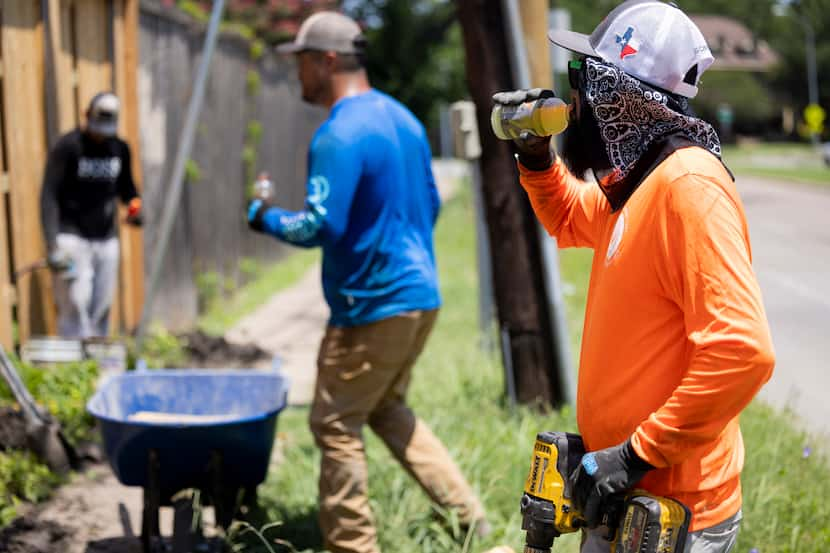Dangerous extreme heat could worsen in key areas of Dallas, affecting vulnerable populations, advocates say.
Those neighborhoods include the Bishop Arts District, Medical District and West Dallas, according to a new urban heat island effect study. In these areas, the temperature was 10 degrees hotter than in other parts of the city.
Heat islands are urbanized areas that experience higher temperatures than the surrounding countryside.
Buildings and roads absorb and release more of the sun’s heat than natural landscapes. Areas where such structures are concentrated and green space is limited become “heat islands,” according to the Environmental Protection Agency.
Other areas identified as “heat islands” in the study include Love Field, Uptown, Oak Lawn, downtown, Deep Ellum, the Design District and Market Center.
“Heat doesn’t really discriminate,” City Council member Carolyn King Arnold said at a news conference on the study’s results. “What we also understand and even focus on is that when the heat exceeds what is kind of normal heat, it continues to affect our health.”
The idea of mapping the hottest spots in cities is to identify them and help cities make decisions about how to combat extreme heat for the well-being of their residents, explained Carlos Evans, director of the Dallas Office of Environmental Quality and Sustainability.
The study was conducted in August with volunteers recording temperatures across the city at three different times a day.
In 2023, Texas saw record heat waves with triple-digit temperatures and more than 20 people died in Dallas and Tarrant counties from heat-related illnesses, according to the counties’ medical examiners. Heat-related emergency visits to hospitals also spiked.
The nine routes in the study included some points of interest such as City Hall, St. Philips School, Fish Trap Lake, the Joppa neighborhood, Dallas Zoo, McCommas Bluff landfill and others.
Some of these areas also are identified as “environmental justice communities,” where a batch plant or shingle manufacturer is located close to a neighborhood, Evans noted.
Dallas joined other cities — including Salt Lake City, Oklahoma City and Sedona — in the National Oceanic and Atmospheric Administration’s 2023 Urban Island Mapping Campaign.
‘No time to wait’
City officials are moving in the right direction by participating in such studies, said Rose Jones, an anthropologist and extreme heat researcher in Dallas. Still, action must be taken soon because “there is no time to wait.”
Officials already know which areas are most impacted by heat and while collecting more data is helpful, solutions are needed now to prevent vulnerable populations from suffering from extreme heat this coming summer, said Jones, founder of Rapid Anthropology Consulting.
Some work is already underway, City Council members noted. For example, the nonprofit Texas Tree Foundation is working closely with the city to plant more trees in the heat island areas.
“I pledged to work with council members to find opportunities to expand the green spaces and energy measures to reduce the impact of a heat island effect in their districts,” said Kathy Stewart, council member and chair of the Parks, Trails and the Environment Committee.
Jones suggested Dallas join other cities such as Miami and Los Angeles in creating a “chief heat officer” position to focus on solutions and preparedness for heat-related emergencies.
“These are the kinds of problems that are going to require new thought processes, new ways of engaging people, and new approaches,” Jones said.
Evans said such a position will depend on the willingness of council members and the city manager to budget for it. Meanwhile, his department is working with the Resiliency Department to continue the heat island study.
The continuation of the study would finish mapping the city and is expected to occur in late July or August. About 200 volunteers will be needed, Evans said.
The results of the heat mapping can be found on www.greendallas.net.


/cloudfront-us-east-1.images.arcpublishing.com/dmn/ABKZQ4P5UJEBXBJWZTKSYEMZ4I.jpg)
/cloudfront-us-east-1.images.arcpublishing.com/dmn/OZ7MZ6DIXAFYWL7OCWDVEIXZCM.jpg)
/cloudfront-us-east-1.images.arcpublishing.com/dmn/VA4GF654JJBG7EOSQXITIZTDSY.jpg)
/cloudfront-us-east-1.images.arcpublishing.com/dmn/CC7ULBMWU5GBFB7MBVGUNTIGVM.jpg)
/cloudfront-us-east-1.images.arcpublishing.com/dmn/7VLBTLQYTWIQG2G6HRF7QO47EM.jpg)